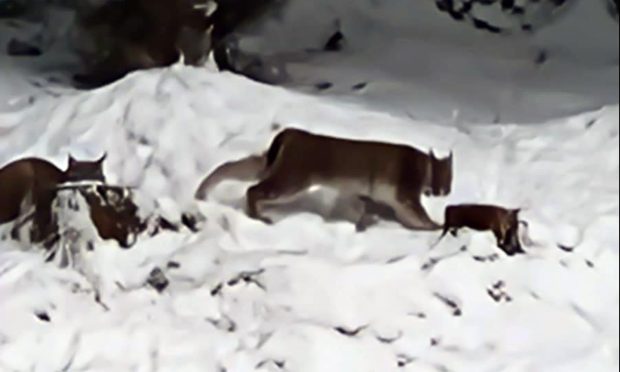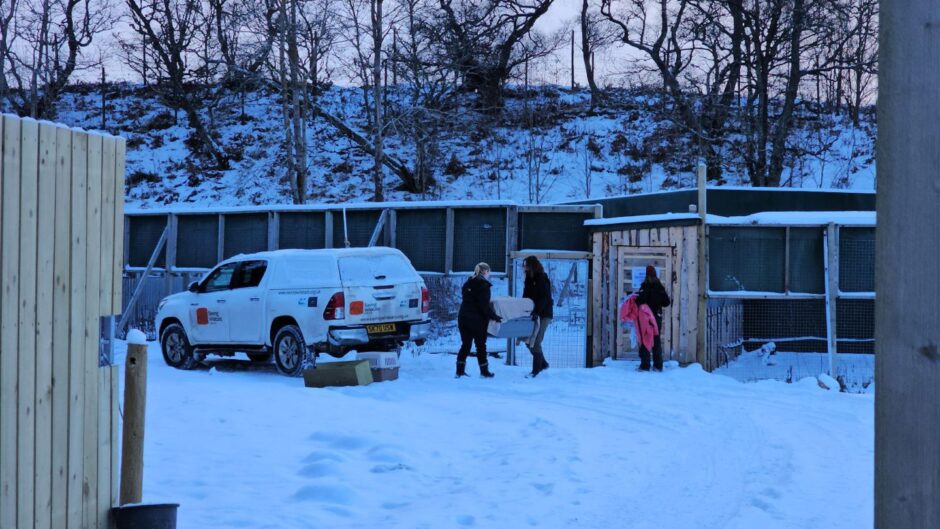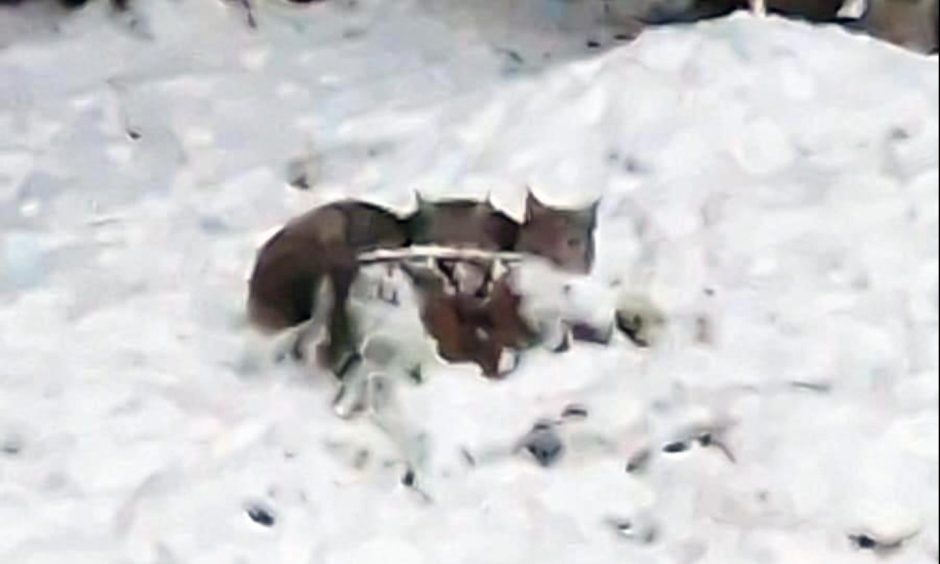A search team braved freezing temperatures through a tense stake-out in the Cairngorms to capture two lynx that had been let loose into the wild.
Specially-trained staff from the Kincraig-based Highland Wildlife Park were scrambled to the Drumguish area near Kingussie on Wednesday afternoon to reports of wild cats on the loose.
Within 24 hours, the cats were located, captured and quarantined before being transferred to their sister site at Edinburgh Zoo.
The pair will remain in quarantine for 30 days, undergoing medical screenings and tests as teams put together a plan for their future.
Meanwhile, police have launched an investigation to establish who “dumped” the pair in the wild.
Lynx spotted hiding behind a log in the Cairngorms
David Barclay, ex-situ conservation manager at the wildlife park, spoke to The Press and Journal earlier today about the complexities of the 13-hour rescue operation.
He explained how a member of the public raised the alarm, prompting what would be a long and cold operation.
Upon hearing what they first thought to be an “outlandish claim”, they were produced with a photograph which confirmed the sighting.
Eager to track their movements, a member of the park field team made their way to the identified area of the Cairngorms National Park, alongside several local residents.
A short time later, David made his way to the scene and he recalled the moment he spotted the lynx for the first time, cowering behind a log.
“Although I had seen the image, I walked along from where they were first sighted on the off-chance they were still there and I could confirm it myself. Right enough, I saw two lynx hiding behind a log,” he said.
Monitoring the pair from a distance, the team kept the area quiet as police and a wildlife crime officer made their way to the location.
Upon arrival, officers reached out to the Scottish SSPCA to take the lead on capturing the cats.
However, due to a lack of capacity, staff from the Highland Wildlife Park stepped in to offer their assistance.
Traps set to capture the animals
Staff proceeded to set a number of traps, tying food to the inside, in a bid to entice the animals.
David said that from there, it was a waiting game that thankfully paid off.
He added: “When we trap animals – its a standard practice and we do this with wildcats and other species both within and outside of the park – we have live capture traps we tie food to the back of, and then we put up a camera which gives us live imaging.
“We were able to do that and set up three traps, come away from the area and do shifts through the night; every couple of hours looking at the live images from the cameras.”
By 4am, teams had successfully captured one of the cats, with the other meandering close by.
The conservation manager added: “This morning around 4am we had the first cat in the trap. We went out and got ready to bring that animal back to the quarantine facility here. But whilst we were doing that, the second one came out the trees and was walking past us while we were preparing the first one.
“We reset another trap and moved out of the area when we had the first one secure. About 30 minutes later, the second one went in and that was that.
“We were able to bring both of them safely back to the quarantine facility.”
Staff believe the cats, understood to be Eurasian lynx, are no more than two-year-old siblings that have been reared in a captive facility.
Early indications suggest they moved only 300 metres from where they were released.
“They didn’t want to move far. If you include that with their behaviour, I think it adds to the fact these animals were quite scared to be just dumped like that,” David explained.
“It’s not good for their welfare, a shame for them and another indication that it’s good that we have them in safe hands.”
The lynx have since been nicknamed “The KillieHuntly Two” and appear to be in good health.
‘These cats were not prepared for life in the wild’
David, who also holds the role of manager of the RZSS Saving Wildcats team, spoke of the dangers of “illegally releasing” animals into the wild; particularly concerning disease and bio-security.
He said: “These two cats are clearly not wild animals.
“They are habituated to people and from a captive facility of some sort. They are really not prepared for life in these kinds of harsh conditions.
“The unlawful and bad practice release of an animal like this is not good for many reasons. There is a risk for animals that have not been prepared for life in the wild and it also poses a significant disease risk and bio-security risk to other animals.
“It’s not good for the community, really not good for the cats and we are glad that we’ve been able to resolve it.”
‘Animals can’t just be taken to a forest and let go’
David warned of the dangers, concluding: “I think sometimes people think that freeing animals to the wild is in their best interest – that it fits with a utopian view of the world, where the animals will suddenly revert back to being a Lion King.
“But it’s not. The wild is a very harsh environment to live in.
“Wildcats that we have been releasing over the last couple of years legally and following best practices have been specifically prepared for life in the wild, and they are doing very well.
“Animals can’t just be taken to a forest and let go. It’s not fair on them, it does nothing for their welfare and it’s not fair on the people of the community.”
The deliberate release of the animals even made Holyrood today during First Minister’s Questions.
Scottish Conservative Highlands and Islands MSP Edward Mountain described the criminal act as “reckless and ignorant”.
“The release of these lynx was not only reckless and ignorant but also illegal,” he said.
“There is a reason why the reintroduction of species is carefully regulated, and those responsible must be caught and face the full force of the law.
“If these lynx were not caught, it is likely that they would have died. I am relieved that the animals are safe, but it is important that we recognise the significance of this serious wildlife crime.”




Conversation